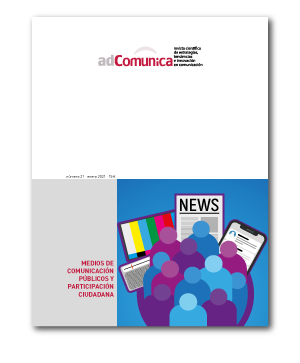Experiencias de co-creación en Medios de Servicio Público Europeos: Visión y Tendencias
Contenido principal del artículo
Resumen
La co-creación es un concepto que tiene cada vez más peso en los planteamientos estratégicos de los medios de servicio público, en particular por su potencial innovador, ofreciéndoles a las corporaciones un mecanismo para generar un valor conjunto con su audiencia, volviéndose más relevantes socialmente y cumpliendo con sus compromisos de servicio público. Sin embargo, la ambigüedad en la descripción de este concepto se traduce en muy diversas concepciones del mismo, siendo aplicado de diferentes maneras a través de los PSM europeos. Los resultados muestran cómo las corporaciones utilizan este mecanismo con diferentes propósitos: conseguir feedback por parte de los usuarios, generar valor colaborando en la creación de sus contenidos, o potenciar el engagement en versiones más clásicas de la participación.
Descargas
Detalles del artículo
1. Política propuesta para Revistas que ofrecen Acceso Abierto
Los autores que publican en esta revista están de acuerdo con los siguientes términos:
- Los autores conservan los derechos de autor y garantizan a la revista el derecho de ser la primera publicación del trabajo al igual que licenciado bajo la licencia CC BY-SA, que permite a otros compartir el trabajo con un reconocimiento de la autoría del trabajo y la publicación inicial en esta revista.
- Los autores pueden establecer por separado acuerdos adicionales para la distribución no exclusiva de la versión de la obra publicada en la revista (por ejemplo, situarlo en un repositorio institucional o publicarlo en un libro), con un reconocimiento de su publicación inicial en esta revista.
Citas
Banks, John (2009). Co-Creative Expertise: Auran Games and Fury – A Case Study. En: Media International Australia, nº130. Saint Lucia: University of Queensland, 77-89.
Bruns, Axel (2008). Blogs, Wikipedia, Second-Life, and beyond: From Production to Produsage. Nueva York: Peter Lang Publishing.
Hallin, Daniel C. y Mancini, Paolo (2004). Sistemas mediáticos comparados: tres modelos de relación entre los medios de comunicación y la política. Cambridge: Cambridge University Press. doi:10.1017/CBO9780511790867
Hoff, Jens Villiam (2010). The Internet and Democratic Citizenship: Theory, Practice & Policy.. En: Information,
Communication & Society, vol.8, nº13. Londres: Routledge, 1230-1232.
Hutchinson, Jonathon (2017). Cultural Intermediaries. Audience Participation in Media Organisations. Nueva York: Palgrave Macmillan.
Khajeheian, Datis y Tadayoni, Reza (2016). User innovation in public service broadcasts: creating public value by media entrepreneurship. En: International Journal of Technology Transfer and Commercialisation, vol.14, nº2. Milton Keynes: Inderscience, 117-131.
Kim, Jin (2012). The institutionalization of YouTube: From user-generated content to professionally generated content. En: Media, Culture and Society, vol.34, nº1. Londres: Sage, 53-67.
López-Cepeda, Ana; López-Golán, Mónica y Rodríguez-Castro, Marta (2019). Participatory audiences in the European public service media: Content production and copyright. En: Comunicar, vol.60. Huelva: Grupo Comunicar, 93-102. doi:
https://doi.org/10.3916/C60-2019-09
Marzal-Felici, Javier; Soler Campillo, María y López Olano, Carlos (2020). Participació ciutadana i mitjans de comunicació públics. Resultats de focus groups a acadèmics, professionals i experts en dinamització social. En: Quaderns del CAC, nº 46. Barcelona: Consell de l’Audiovisual de Catalunya, 13-23.
McGonagle, Tarlach (2013). User-generated Content and Audiovisual News: The Ups and Downs of an Uncertain Relationship. En: Open Journalism. Estrasburgo: Observatorio Audiovisual Europeo.
OCDE (2007). Participative web and user-created content: Web 2.0, wikis and social networking. Working Party on the Information Economy. Paris: Organisation for Economic Co-operation and Development.
Prahalad, C. K. y Ramaswamy, Venkat (2004). Co-creation experiences: The next practice in value creation. En: Journal of Interactive Marketing, vol.18, nº3. Nueva York: Wiley, 5-14.
Tambini, Damian (2015). Five theses on public media and digitization: From a 56- country study. En: International Journal of Communication, nº9. Los Angeles: The Annenberg Center for Communication, 1400-1424.
Thurman, Neil y Hermida, Alfred (2010). Gotcha: How newsroom norms are shaping participatory journalism online. En: Tunney, Sean y Monaghan, Garrett (Eds.), Web Journalism: A New Form of Citizenship?. Eastbourne: Sussex Academic Press.
Túñez-López, Miguel; Vaz-Álvarez, Martín y Fieiras-Ceide, César (2020). Covid-19 and public service media: Impact of the pandemic on public television in Europe. En: El Profesional de la información, vol.29, nº5. Barcelona: EPI. doi:
https://doi.org/10.3145/epi.2020.sep.18
Van den Bulck, Hilde y Moe, Hallvard (2017). Public service media, universality and personalisation through algorithms: mapping strategies and exploring dilemmas. En: Media, Culture & Society, vol.40,nº6. Londres: Sage, 875-892. doi:
https://doi.org/10.1177%2F0163443717734407
Vanhaeght, Anne-Sofie (2019). The need for not more, but more socially relevant audience participation in public service media. En: Media, Culture & Society, vol.41, nº6. Londres: Sage, 120-137.
Vaz-Álvarez, Martín; Túñez-López, Miguel y Frazão-Nogueira, Ana Gabriela (2020). Co-creating value in European Public Service Media An analysis of 4 succesful co-creation experiences in public television. En: 15th Iberian Conference on Information Systems and Technologies (CISTI). Sevilla, Spain, 1-4, doi: 10.23919/CISTI49556.2020.9141024.
Westlund, Oscar y Lewis, Seth C. (2014). Agents of Media Innovations: Actors, Actants, and Audiences. En: The Journal of Media Innovations, vol.1, nº2. Oslo: Centre for Research on Media Innovations, 10-35.


